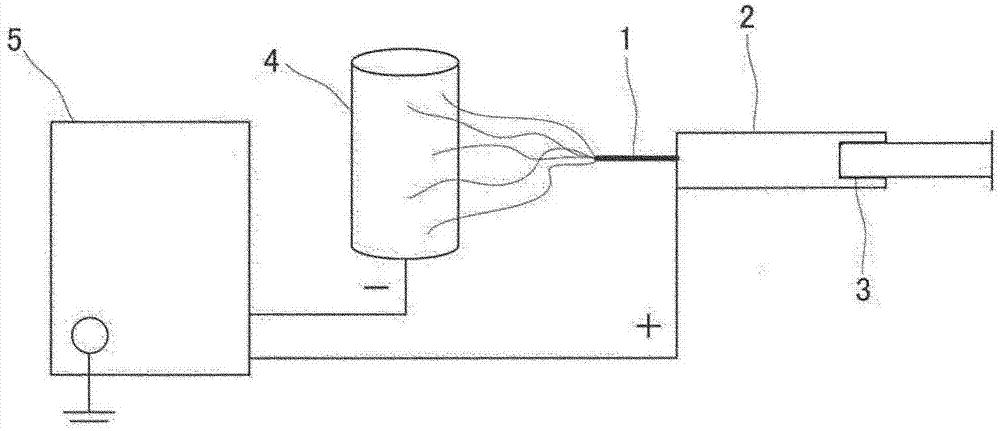Silicone-modified polyurethane-based fiber and method for manufacturing same
A manufacturing method, silicone technology, applied in the direction of one-component polyurethane rayon, fiber chemical characteristics, one-component synthetic polymer rayon, etc., can solve poor adhesion resistance, poor processability, low sliding property, and low softness and other problems, to achieve the effect of excellent spinnability
- Summary
- Abstract
- Description
- Claims
- Application Information
AI Technical Summary
Problems solved by technology
Method used
Image
Examples
Embodiment
[0123] Although the present invention will be specifically described below based on examples and comparative examples, the present invention is not limited to these examples. In addition, "part" and "%" in an Example and a comparative example are a mass standard unless otherwise indicated. In addition, the evaluation items in each of the following Examples and Comparative Examples were implemented by the method described below.
[0124] In the following examples, the number average molecular weight (Mn) is a value in terms of polymethyl methacrylate (PMMA) measured by gel permeation chromatography (GPC). In addition, GPC measurement was performed under the conditions of apparatus: HLC-8320GPC (manufactured by Tosoh Corporation), solvent: tetrahydrofuran (THF), and resin concentration: 0.1%.
[0125]
Synthetic example 1
[0126] (Synthesis Example 1: Synthesis of SiPU1)
[0127] A reaction container having a stirrer, a reflux condenser, a thermometer, a nitrogen blowing tube, and an opening was prepared. While replacing the inside of the reaction vessel with nitrogen, 200 g of polytetramethylene glycol (trade name "PolyTHF1000", manufactured by BASF Japan, number average molecular weight 1,000, hydroxyl value 113 mgKOH / g), 1,4- 38 g of butanediol, 0.5 g of double-terminal silicone diol (n=10 in compound (2-1)), and 591.8 g of dimethylformamide (DMF). Heating and stirring was started, and after the system became uniform, 156.0 g of 4,4'-methylenebis(phenylene isocyanate) (MDI) was added at 50°C, and then the temperature was raised to 80°C for reaction. The reaction was carried out until the 2,270 cm of free isocyanate groups determined by infrared absorption spectroscopic analysis -1 The absorption disappears. Then, 52.6 g of DMF and 276.2 g of methyl ethyl ketone (MEK) were added to obtain a...
Synthetic example 2
[0128] (Synthesis Example 2: Synthesis of SiPU2)
[0129] A reaction container having a stirrer, a reflux condenser, a thermometer, a nitrogen blowing tube, and an opening was prepared. While replacing the inside of the reaction vessel with nitrogen, 200 g of polytetramethylene glycol (trade name "PolyTHF1000", manufactured by BASF Japan, number average molecular weight 1,000, hydroxyl value 113 mgKOH / g), 1,4- 38 g of butanediol, 5 g of double-terminal silicone diol (n=10 in compound (2-1), 599.4 g of dimethylformamide (DMF). Heating and stirring was started, and after the system became uniform, 156.6 g of 4,4'-methylene bis(phenylene isocyanate) (MDI) was added at 50°C, and then the temperature was raised to 80°C for reaction. The reaction was carried out until the 2,270 cm of free isocyanate groups determined by infrared absorption spectroscopic analysis -1 The absorption disappears. Then, 53.3 g of DMF and 279.7 g of methyl ethyl ketone (MEK) were added to obtain a solut...
PUM
| Property | Measurement | Unit |
|---|---|---|
| diameter | aaaaa | aaaaa |
| elastic modulus | aaaaa | aaaaa |
| water contact angle | aaaaa | aaaaa |
Abstract
Description
Claims
Application Information
 Login to View More
Login to View More - R&D
- Intellectual Property
- Life Sciences
- Materials
- Tech Scout
- Unparalleled Data Quality
- Higher Quality Content
- 60% Fewer Hallucinations
Browse by: Latest US Patents, China's latest patents, Technical Efficacy Thesaurus, Application Domain, Technology Topic, Popular Technical Reports.
© 2025 PatSnap. All rights reserved.Legal|Privacy policy|Modern Slavery Act Transparency Statement|Sitemap|About US| Contact US: help@patsnap.com



